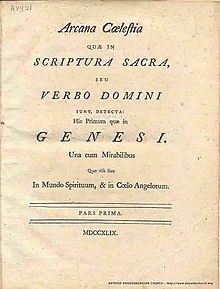Arcana Cœlestia
The Arcana Cœlestia, quae in Scriptura Sacra seu Verbo Domini sunt, detecta, usually abbreviated as Arcana Cœlestia (Heavenly Mysteries or Secrets of Heaven) or under its Latin variant, Arcana Cælestia,[1] is an 8-volume theological work published by Emanuel Swedenborg in the 1750s.[2][3]

Overview
Swedenborg was born in Sweden in 1688. His father was a Christian pastor in the Lutheran Church. The first part of his life was devoted to studying sciences, especially metallurgy. In 1740 he published Oeconomia Regni Animalis (Dynamics of the Soul's Domain), where he looked at connections between the spiritual and physical worlds. In 1744 he underwent a spiritual awakening and started to record his experiences and visions. Arcana Cœlestia was his first theological publication. It was published in London, partly to avoid Swedish anti-heresy laws.[4]
Structure
The publication is a spiritual interpretation of Genesis and Exodus (the first two books of the Bible), according to the doctrine of correspondence (theology), and demonstrated by many supporting quotations from the Hebrew Bible and the New Testament. While not denying the historicity of the stories of the Patriarchs and the Exodus from Egypt, it explains them as describing symbolically the process of spiritual growth and struggles in each individual person.
The Latin volumes are laid out as follows;[5]
- Volume 1, Genesis Chapters 1–15
- Volume 2, Genesis Chapters 16–21
- Volume 3, Genesis Chapters 22–30
- Volume 4, Genesis Chapters 31–40
- Volume 5, Genesis Chapters 41–50
- Volume 6, Exodus Chapters 1–15
- Volume 7, Exodus Chapters 16–24
- Volume 8, Exodus Chapters 25–40
The English volumes are laid out as follows;[5]
- Volume 1, Genesis Chapters 1–9
- Volume 2, Genesis Chapters 10–17
- Volume 3, Genesis Chapters 18–22
- Volume 4, Genesis Chapters 23–27
- Volume 5, Genesis Chapters 29–31
- Volume 6, Genesis Chapters 32–38
- Volume 7, Genesis Chapters 39–43
- Volume 8, Genesis Chapters 44–50
- Volume 9, Exodus Chapters 1–12
- Volume 10, Exodus Chapters 13–21
- Volume 11, Exodus Chapters 22–28
- Volume 12, Exodus Chapters 29–40
Preface
The opening paragraph of Arcana Coelestia Volume 1 is the opening statement of the corpus of theological work that Swedenborg claimed was revealed to him.[6]
From the mere letter of the Word of the Old Testament no one would ever discern the fact that this part of the Word contains deep secrets of heaven, and that everything within it both in general and in particular bears reference to the Lord, to His heaven, to the church, to religious belief, and to all things connected therewith; for from the letter or sense of the letter all that anyone can see is that - to speak generally - everything therein has reference merely to the external rites and ordinances of the Jewish Church. Yet the truth is that everywhere in that Word there are internal things which never appear at all in the external things except a very few which the Lord revealed and explained to the Apostles; such as that the sacrifices signify the Lord; that the land of Canaan and Jerusalem signify heaven - on which account they are called the Heavenly Canaan and Jerusalem - and that Paradise has a similar signification. (Arcana Cœlestia #1)
Editions
There have been several translations made of Arcana Cœlestia (together with the rest of Swedenborg's theological work), including:
Swedenborg Foundation Standard Edition (12 volumes)
Volumes of the Standard Edition were originally issued from 1929 to 1956, with the majority in 1938.
Swedenborg Society (12 volumes)
This is a new contemporary translation.
Swedenborg Foundation New Century Edition (3 of 15 volumes currently available)
This edition was updated in the 1900s.[7]
The Neo-Latin original (8 volumes)
Swedenborg's theological work the Arcana Coelestia, published from 1749 to 1756 were originally written in Neo-Latin.[8][9]
The first translation into English
The translation from Neo-Latin into English was commissioned by Swedenborg himself.
Summaries and comments
The Reviser Preface contains a summary of the publishing history for the work originally published by Swedenborg.[10][11]
Notes
- ^ Cf. Michelle Grier, 'Swedenborg and Kant on Spiritual Intuition' in On the True Philosopher: Essays on Swedenborg, ed. Stephen McNeilly (London: Swedenborg Society, 2002), p. 1. Accessed November 11, 2010.
- ^ In the 12-volume standard English edition of the Arcana Coelestia, revised and edited by Rev. John Faulkner Potts and published by the Swedenborg Foundation in 1956, the prefatory notes by the reviser contains a summary of the publishing history for the work originally published by Swedenborg.
- ^ "Redesigned Standard Edition Downloads - Swedenborg Foundation". swedenborg.com. 12 April 2013. Retrieved 23 August 2023.
- ^ "Swedenborg's Biography - Swedenborg Foundation". swedenborg.com. 1 March 2013. Retrieved 23 August 2023.
- ^ a b "Theological Writings of Emanuel Swedenborg".
- ^ "The Writings of Emanuel Swedenborg - New Christian Bible Study".
- ^ "The New Century Edition". Swedenborg Foundation. 2 April 2013. Retrieved 6 August 2019.
- ^ "Arcana Coelestia #1 (Original Latin) - New Christian Bible Study".
- ^ "BaysideChurch.org - Scan of the First Edition of Swedenborg's Writings". www.baysidechurch.org. Retrieved 23 August 2023.
- ^ "Arcana Coelestia Vol. 1" (PDF). Swedenborg Foundation.
- ^ "Arcana Caelestia vol. 1, Elliott, hardback". www.newchurchbooks.com. Retrieved 23 August 2023.
Bibliography
- ISBN 0-87785-214-6
- ISBN 978-0-87785-214-8
- Sigstedt, C., The Swedenborg Epic. The Life and Works of Emanuel Swedenborg (New York: Bookman Associates, 1952, Chapter 27)
